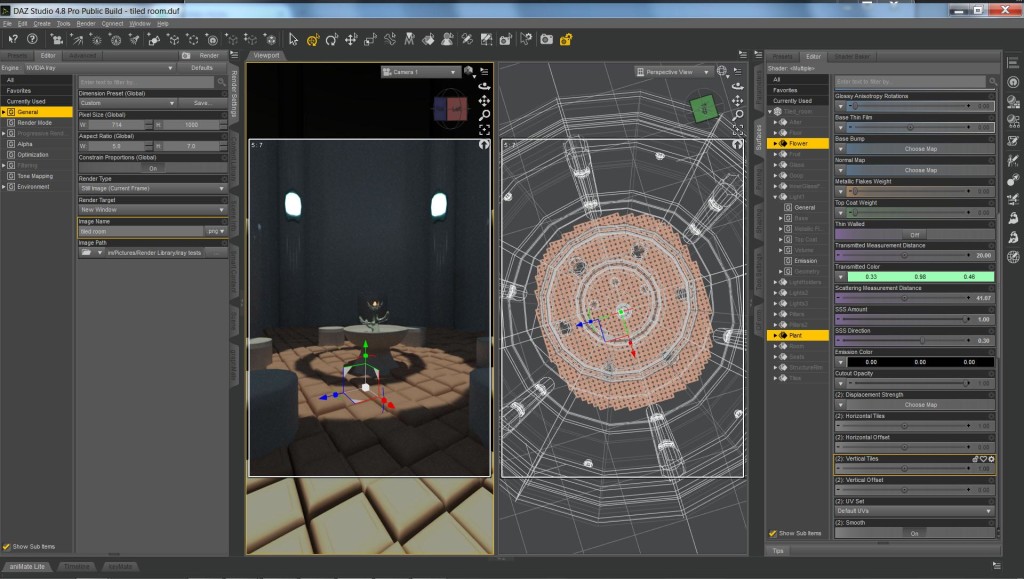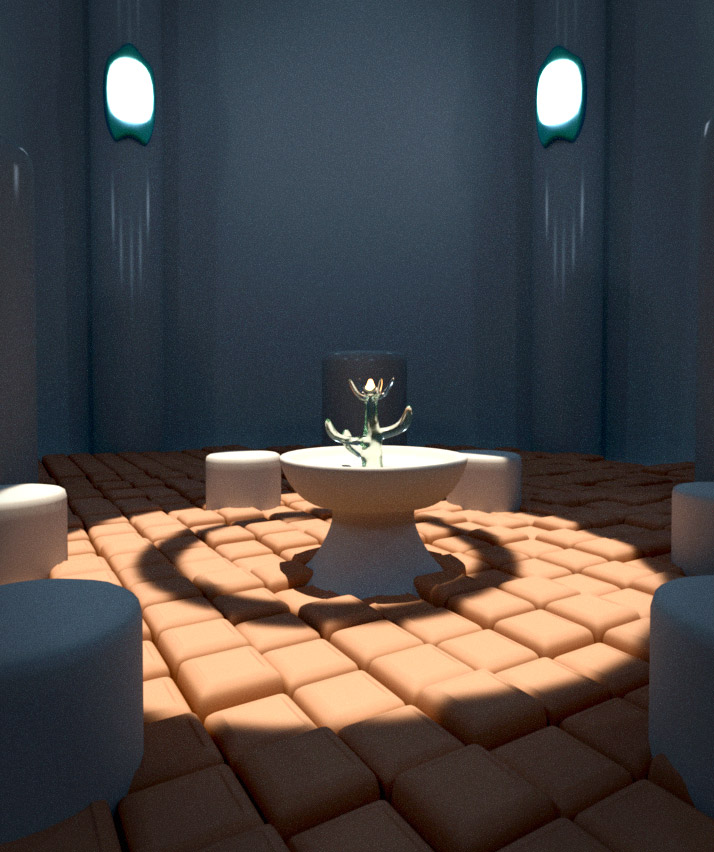*See this article for graphics card suggestions.
 DAZ Studio users have been enjoying unbiased, physically based rendering (PBR) via GPU for a good while now. The go to for many users up till now has been LuxRender via the Reality and Luxus series of plugins. Octane and it’s tightly integrated plugin for DAZ Studio has been embraced by both, professionals, and enthusiasts with more cheddar to throw at their hobby. Now with DAZ Studio 4.8x (aka Project Iradium – a clever little play on words), DAZ 3D has gone big and, thanks to a recent deal signed with Nvidia, brought production grade unbiased GPU rendering to the masses.
DAZ Studio users have been enjoying unbiased, physically based rendering (PBR) via GPU for a good while now. The go to for many users up till now has been LuxRender via the Reality and Luxus series of plugins. Octane and it’s tightly integrated plugin for DAZ Studio has been embraced by both, professionals, and enthusiasts with more cheddar to throw at their hobby. Now with DAZ Studio 4.8x (aka Project Iradium – a clever little play on words), DAZ 3D has gone big and, thanks to a recent deal signed with Nvidia, brought production grade unbiased GPU rendering to the masses.
Not familiar with Iray? Just type “Iray” into Google and prepare to have your jaw dropped. The exact details of the deal aren’t clear. I’ve contacted D3D for comment and will post any details that come to light, but any way you slice it, unbiased GPU at this level is a very cool tool to have tightly integrated into DS, especially when sitting alongside 3Delight, DS’s long-time primary render engine.
In this article:
- The usual explanations – CUDA, OCL, Unbiased etc (for dinosaurs and noobs)
- Basics of using Iray – surfaces and rendering
- Iray vs LuxRender
CUDA, OpenCL, Unbiased, GPU – What Does It All Mean?
There is still a good deal of confusion in the community about CUDA, OpenCL, unbiased rendering, and GPU based rendering. As some already know, and others will guess, Iray is a CUDA based engine, so those with newer and beefier Nvidia cards (ie. those with more CUDA cores) will have the most to gain from the new engine. Those with AMD cards (myself included) miss out on all the accelerated goodness, but luckily, we can still make use of Iray as it also includes CPU options.
So, the short:
CUDA is strictly a technology accessible to only those with Nvidia cards
Iray is CUDA reliant for GPU modes of rendering, but those with cards without CUDA cores can still make use of Iray’s CPU modes.
OpenCL is supported by both AMD and Nvidia, but AMD have adopted it to a greater extent. Most examples of programs that utilise OpenCL tend to be much faster on AMD cards.
Unbiased rendering algorithms simulate the way light interacts with geometry and materials in such a way that the results are physically plausible, sometimes to the point where observers are unable to determine the difference between a photograph and a 3D rendering. It is therefore easier to light a scene for unbiased rendering than for one that will be rendered with a biased engine, which often require the placement of more lights and wizardry to produce plausible or aesthetically pleasing results.
The trade-off that has kept unbiased engines in the domain of super geeks and the artistic fringe is that all those simulated photons and surface interactions are incredibly expensive, in terms of processing power. For film and television all those extra cycles can quickly blow the budget. In recent years the massive parallel processing power of graphics cards has seen the development of software to move the burden off the CPU and onto the GPU.
That’s the basics, and in a few short years anyone that happens to read this will smile at my quaint assumption that such things still need to be explained.
Using Iray: The Very Basic Basics

Iray stuff in action.
Getting The Latest DAZ Studio Public Beta
If you have not yet picked up a free copy of a beta from the DAZ store, pay a quick visit to the DAZ Studio Beta page and add it to your cart. If you have already participated in a beta from the post 4.5x days you can download it from DIM or your product library on DAZ 3D’s site. The steps are a little convoluted for DIM, but if you check out the beta thread on the forum you’ll get there. [Ed] Somehow I missed the fact that the beta page also includes screen caps to show the exact process for installing with DIM.
Surfaces
DAZ have clearly done a lot of work integrating Iray into DAZ Studio. Though the current offering is still a public beta it is easy to get up and running with Iray in minutes. The default DAZ shader translates quite effectively into Iray, as does Age of Armour’s Subsurface Shader Base (SSB), but for best results it is suggestible to apply the Iray ubershader or a fitting shader preset. These presets are all easy to access from Surfaces (tab) > Preset > Shaders > Iray.
Anyone that has any experience SSB or UberSurface should be able to quickly recognise the various inputs and controllers. There is also a pretty darn good preset for G2 characters, though I think it works best for those of lighter skin.
Rendering
Rendering is also a breeze. Render Settings (tab) > Engine > NVIDIA Iray. In many cases you can simply hit render. There are some options to play with, especially when it comes to playing with the sun/sky model and tone mapping. Think photography on the latter there – all very familiar to Lux users and photographers, though the values and controls seem to produce some odd results.

45 mins to render? Don’t recall exactly now
LuxRender Vs Iray
There has been a good deal of debate on the various community forums whether Lux or Iray is faster in both CPU and GPU modes. Given that I’ve slipped behind on LuxRender in recent times I don’t have anything solid to add to the debate. With CUDA and Iray being more mature than both OpenCL and LuxRender I’d take a punt on Iray in both cases. For those willing to forego the most physically accurate results Lux probably has the upper hand as both Luxus and Reality expose a number of Lux’s alternate algorithms, which can produce some great results quickly.
A bonus of Iray is that DAZ have implemented a very nice progressive preview viewport option. This means we can see all the tweaks we make rendered before our eyes in a close approximation to how our final render will look. Compare this with Luxus’ preview, which is perhaps marginally faster (and more restrictive) than exporting to the Lux GUI. Of course, 3Delight users have been enjoying a progressive preview since the DS 4.7x general release.
I have noted that the Iray viewport preview, at least on my CPU, lags and crashes Studio if I ask too much from it too quickly. Given the CPU intensive nature of the preview this is not unexpected, but hopefully DAZ will have a solution to minimise this inconvenience, assuming this is a problem for CPU users in general, and not just me.
The one department Lux stands head and shoulders over the current implementation of Iray in DAZ Studio is its external GUI. With Lux’s GUI you can alter tone mapping and light settings on the fly, along with adding and configuring post effects such as bloom and vignetting. Hopefully we will see similar features for Iray incorporated into the DS GUI.
With OpenCL, and the render engines that utilise it, still playing catch-up to Nvidia’s CUDA technology it is likely plugins like Reality for DAZ Studio will take a hit, but with AMD cards remaining considerably cheaper than those offered by Nvidia , and with more advanced rendering algorithms moving into LuxRender’s pure GPU, it is likely that Lux and Reality will be with DAZ users for years to come.
Conclusion: Being a lover of new toys I am once again considering Nvidia cards against a list of priorities.





